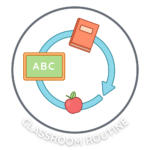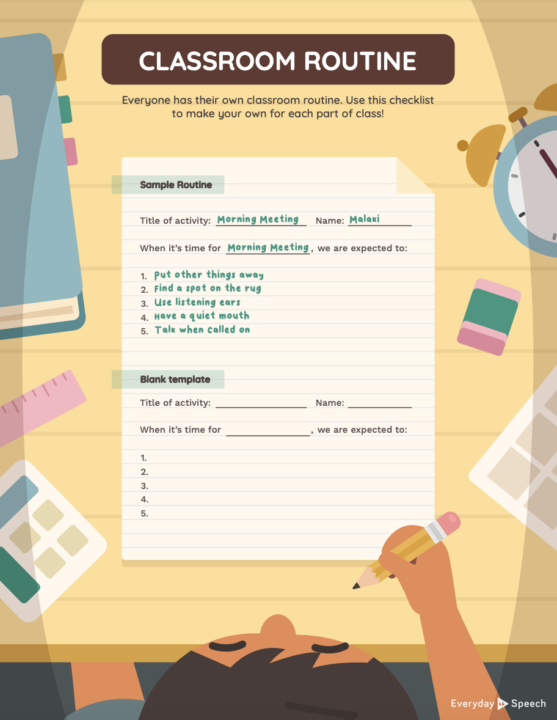Download 30+ Printable Social Skills Posters
Ready-to-use visuals for emotional regulation, self-advocacy, and more

Establishing and maintaining classroom routines is essential for creating a structured and productive learning environment in elementary schools. Classroom routines help students understand expectations, reduce anxiety, and foster a sense of security. Everyday Speech offers a Classroom Routine goal poster that can be an invaluable tool for teachers to reinforce these routines. In this blog post, we will explore how to use the Elementary Classroom Routine Poster to effectively teach and implement classroom routines.
Why Classroom Routines Matter
Classroom routines are vital for several reasons:
- Consistency and Predictability: Help students know what to expect, which reduces anxiety and increases comfort.
- Time Management: Ensure that instructional time is used efficiently and effectively.
- Behavior Management: Minimize disruptions and promote positive behavior.
- Academic Success: Create an environment conducive to learning, which enhances student performance.
Introducing the Classroom Routine Poster
The Classroom Routine goal poster from Everyday Speech is designed to visually guide students through daily routines. It serves as a constant reminder of what is expected, helping students stay on track and transition smoothly between activities. The poster can be customized to fit the specific routines of your classroom, making it a versatile tool for any elementary setting.

Lesson Plan: Using the Classroom Routine Poster
Objective
By the end of the lesson, students will understand the importance of classroom routines and be able to follow the established routines independently.
Materials Needed
- Everyday Speech Classroom Routine Poster
- Markers or pens
- Sticky notes
Duration
30 minutes
Activity Steps
1. Introduction to Classroom Routines (5 minutes)
Begin the lesson by discussing the concept of routines with the students. Explain how routines help everyone know what to expect and keep the classroom running smoothly. Use simple language and examples that are relevant to their daily experiences, such as morning routines at home or bedtime routines.
2. Introducing the Classroom Routine Poster (5 minutes)
Show the Classroom Routine Poster to the class. Explain that this poster will help everyone remember what to do at different parts of the day. Go through each part of the poster, discussing specific routines and why they are important.
Example Routines to Include:
- Morning Arrival: Unpack bags, hang up coats, and start morning work.
- Transition Times: Moving from one activity to another smoothly.
- Classroom Jobs: Specific tasks assigned to students, such as line leader or board cleaner.
- End of Day: Pack up, clean up the area, and wait for dismissal.
3. Interactive Routine Mapping (10 minutes)
Engage the students in creating a visual map of the classroom routines. Use sticky notes or printable routine cards to write down each routine and place them on the poster. Involve the students in this process to give them ownership and better understanding.
4. Role-Playing and Practice (10 minutes)
Have the students role-play different routines. Assign roles and practice going through the routines as a class. For example, practice the morning arrival routine with some students pretending to arrive and others helping to guide the process.
Example Role-Playing Scenarios:
- Morning Arrival: Students practice unpacking and starting morning work.
- Transition Times: Moving from a reading activity to a math lesson.
- Classroom Jobs: Students practice their assigned jobs, such as watering plants or distributing materials.
- End of Day: Students practice packing up and cleaning their areas.
5. Reflection and Discussion (5 minutes)
After practicing the routines, gather the students for a discussion. Ask questions like:
- Why are routines important?
- How do routines help us in the classroom?
- What can we do to remember and follow our routines?
Encourage students to share their thoughts and reflect on the importance of following routines.
Tips for Success
1. Consistency is Key
Ensure that the routines are followed consistently every day. This helps students internalize the routines and understand their importance.
2. Visual Aids
Use the Classroom Routine Poster as a visual aid to reinforce the routines. Display it prominently in the classroom where all students can see it easily.
3. Positive Reinforcement
Provide positive reinforcement and praise when students follow the routines correctly. This encourages them to continue following the routines.
4. Adapt and Adjust
Be flexible and willing to adjust the routines as needed. If a routine isn’t working well, involve the students in finding a better solution.
Unlock all of our Back-to-School materials by signing up for your free trial today – no credit card required!
Access the full Social Communication Curriculum HERE!
Instant access to thousands of no-prep social skills activities, over 1000+ video lessons, and engaging games designed to enhance learning and development.
Conclusion
Teaching elementary students about classroom routines is essential for creating a structured and effective learning environment. Using the Everyday Speech Classroom Routine Poster, teachers can visually guide students through daily routines, helping them understand and follow the established routines independently. By following the provided lesson plan and incorporating the no-prep activity ideas, educators can support their students in building essential self-regulation and time management skills. For more resources and tips on teaching classroom routines, stay tuned to our blog.
Sample Video
Try out this sample animated video lesson.
We offer our entire Social-Emotional Learning platform free for 14 days here!
Related Blog Posts:
Free Elementary Conversation Topics Material
Promote Social Understanding in Elementary Students with Educational Videos
Enhance Social Skills in Elementary Students with Free Video Resources





